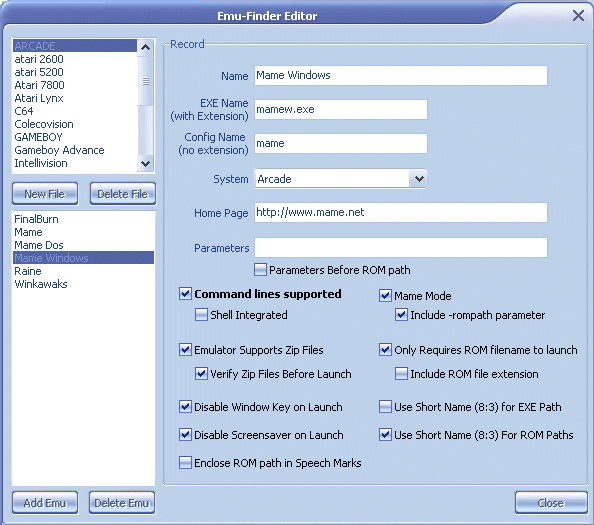Butter100fly (talk | contribs) |
Butter100fly (talk | contribs) |
||
| Line 3: | Line 3: | ||
== Using the Emu-Finder == | == Using the Emu-Finder == | ||
For a guide on how to use the Emu-Finder see the [[Quick_Start|Quick Start Guide]] | For a basic guide on how to use the Emu-Finder see the [[Quick_Start|Quick Start Guide]] | ||
== Making Emu-Finder Files == | == Making Emu-Finder Files == | ||
Revision as of 21:40, 25 November 2017
EFind Wizard
The Emu-Finder wizard is the fastest, simplest way to add new emulators to QuickPlay's database. Using a collection of INI files which contain information about emulators, the Emu-Finder can search your system to locate known emulators.
Using the Emu-Finder
For a basic guide on how to use the Emu-Finder see the Quick Start Guide
Making Emu-Finder Files
One of the strengths of the Emu-Finder is that is infinitely expandable by adding new INI files, or new records to the existing INI files. So if your favourite emulator isnt already in the existing INI files then it is possible to edit the files and add it! In previous versions of QuickPlay this process was complicated, but no more, as QuickPlay now comes with its own built in editor for these files.
The Editor screen consists of a combo box at the top which should be used to select which file you wish to edit. Upon selecting a file the emulators in that file will load in the list box. You can now select an emulator to view or edit its properties. You can also delete this emulator, although this is not recommended. To add a new emulator, simply click the Add button and begin filling in the data related to that emulator. The 'Name' box is how you wish the emulator to be identified in QuickPlay. The EXE Name is the file name of the emulator, this MUST contain a file extension, for example '.exe'. If a configuration file is required then enter the name of this file, with NO extension. The rest of the properties are detailed below
==== System Select the system type this emulator belongs to. Obviously it makes sense to group all the emulators of one system in one INI file, but you don't have to take this approach.
==== Homepage Enter in the emulators homepage - if you know it, if you dont leave it blank.
Command Lines Supported
If the emulator supports command line parameters check this box. Any emulator's which don't support command lines will not be available as a choice when you want to scan in ROMs (although you can launch these emulators from the 'Emulators' branch on the folder listing.
Shell Integrated
If the emulator is integrated into the shell (if you only need to double-click a ROM in explorer to load it) then check this option. This CAN work with zipped files, by specifying that the emulator DOESNT support zips, QuickPlay will extract the file and then execute it.
Mame Mode
The MAME emulator requires parameters in a strange format, if the emulator is MAME then check this box.
Include -rompath parameter
If you have set up the ROM path settings in the 'mame.ini' file you can disable this option. If you havent set up your Mame.ini file then leave this option enabled or your ROMs wont run!
Only requires ROM filename to launch
If the emulator only requires the rom name (and not the full path) to launch games check this option. For example this setting is required for MAME which launches games like this
c:\mame\mame.exe aROM
Include ROM file extension
Works in tandem with the above property. If you need to add the file extension to the name then check this so the paramter would become
c:\mame\mame.exe aROM.zip
Enclose ROM path in speech marks
The ROM path is enclosed in speech marks - "c:\roms\mario.zip", this option may mean you dont have to use short name format for the ROM path, which can mess up save-state names.
Use Short Name (8:3) for ROM paths
If the emulator is fairly old (ie a DOS based emulator), it may only recognise paths in short name format, so check this box. You might also want to try using the 'Enclose ROM path in speech marks' as this may also work with these emulators.
Use Short Name (8:3) for emulator path
Check this box if the emulator being launched has to be launched with a short name format path. Emulators which require this are becoming rare, but may still exist!
Emulator supports Zip files
If the emulator supports zip files then check this box. If the emulator doesnt support zip files Quickplay will extract the ROM to its temporary directory and run it from there.
Verify zip before launch
If the file being launched is a ZIP file, verify that it is a 'valid' zip file.
Disable windows key on launch
When launching a ROM, disable the 'Windows' key.
Disable screensaver on launch
When launching a ROM, disable the screensaver for the duration of your game, so your not interrupted with a scrolling marquee or flying window!

